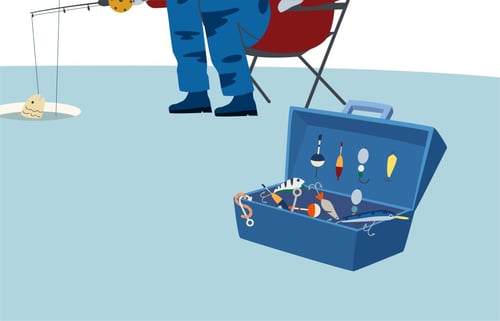
THE EXIT PLANNING BLOG
Keep up-to-date with exit planning, succession planning, industry trends, unique specialty insights, and useful content for professional advisors and business owners.
Share this
How To “Reel In” the Right Customers: Building Your Customer Capital
by Colleen Kowalski on December 15, 2021

In the winter months, lakes and ponds freeze over, the air chills our faces, and we put on layer upon layer of clothing to keep warm. But even so, both professional and amateur fishers continue to sink their rods into the water in hopes of reeling in the big one. Ice Fishing has been around for over two thousand years and continues to be a popular winter activity for fishers across the globe.
Being a successful ice fisher involves a lot of the same strategies as building a successful customer base for your business. Without knowing what fish you want, where to find them, and how to attract them, you are out in the cold for no reason. Learn how to improve your Customer Capital and possibly a thing or two about ice fishing.
Do You Know What Kind of Fish You Want?

Before you set out to ice fish, you must first understand what type of fish you are looking for. What kind of fish do you enjoy eating? Is there a certain fish you have always wanted to catch, but has eluded your reel time and time again? To be a successful fisher, you research the types of fish you want to catch. You know when and where these fish will be active and therefore have a deeper understanding of their habits.
Business owners should conduct the same research on their potential customers. Your business is only as valuable as your ability to share your brand story and purpose to the correct audience. How do you ensure that your message is being delivered to the right target market? Do you even know who that “right” target market is and what their pain points include? Your service is not for everyone so your marketing techniques should not try to reach everyone either. Create buyer persona guidelines to ensure all content created will be valuable to your target audience.
Even with a target customer in mind, your business should not solely depend on any single customer. Should the “fish” you crave go extinct, or your customer decides to leave your business, you must be prepared with a diverse customer pool.
Knowing your customer is the basis for everything that follows.
Are You Fishing in the Wrong Pond?

Now that you know what fish you are looking for, do you know which ice ponds to search for? Imagine getting all of your equipment ready, drilling a hole through over four inches of solid ice, and putting your fishing rod into the water to find: absolutely nothing. Sadly, this dilemma occurs in businesses quite often.
As a business owner, you research the best tools to use and share content but fail to reach your customers in the right way. It does not matter how amazing your message is if you are not reaching the right people. Without understanding your target audience, you will not be able to communicate with them in the correct way, meet their needs, or accept feedback effectively.
It is important to meet your customers where they are, especially early in the customer relationship. As a business owner, you want your customers to view their experiences with your brand as transformational instead of transactional. By building a strong relationship with the customer instead of simply selling your services, you gain a deeper understanding of their business and personal goals. This allows you to make more informed decisions and suggestions for the customer.
Are You Using the Right Bait?

Andrew Martin, Regional Director of the Strategic Specialists Group in New Zealand, shares that it is important for business owners to, “understand your customer journey, develop repeatable processes along the way that match the needs of those customers, and get continuously better at providing to customer needs.”
Highly personalized interactions foster the most engagement between your customers and your brand. Engaging with customers through social media is one of the best ways to create organic connections. According to Investor’s Business Daily, sharing personal stories “has a greater impact than a financial article as people get to know the real you.”
Scott Snider, Exit Planning Institute President, shares, “I think the biggest challenge here is moving our customers from engaged to entangled. What do we do so well with our customers that they couldn’t possibly think about doing business without us? What makes us indispensable to them. That is entanglement.”
Consider the following when looking at the value of your Customer Capital:
- How strong are your relationships with customers?
- Is your business integral to your customers’ success because the products/services you offer are unique?
- Are these relationships deep, long-term, and contractual?
- Are the relationships delivered in a consistent, reliable, and recurring fashion?
- Most of all, are these relationships transferable?
Learn more about Customer Capital in our 5-4-3-2-1: Five Things Every Business Owner Must Know About Exit Planning Whitepaper.
Request the Whitepaper!Share this
- Blog (418)
- CEPA (302)
- exit planning (222)
- CEPA community (167)
- Business Owner (100)
- Exit Planning Summit (72)
- EPI Chapter Network (66)
- Content (48)
- EPI Announcement (46)
- Exit Planning Partner Network (44)
- Value Acceleration Methodology (42)
- Webinars (37)
- Marketing (30)
- 5 Stages of Value Maturity (26)
- 2024 Exit Planning Summit (25)
- Books (24)
- Exit Planning Teams (22)
- 2023 Exit Planning Summit (20)
- EPI Team (20)
- Excellence in Exit Planning Awards (19)
- women in business (19)
- Leadership (17)
- family business (17)
- Black Friday (16)
- Exit Options (16)
- Intangible Capital (16)
- CPA (15)
- EPI Academy (15)
- Chris Snider (13)
- Chapters (12)
- National Accounts (12)
- Small business (12)
- State of Owner Readiness (12)
- charitable intent (12)
- personal planning (12)
- Walking to Destiny (11)
- Financial Advisors (9)
- About us (8)
- Podcast (8)
- 5 Ds (7)
- Insiders Bash (7)
- Case Studies (6)
- Christmas (6)
- Exit Planning Content Library (6)
- Owner Roundtables (5)
- Scott Snider (5)
- Season of Deals (5)
- Value Advisors (5)
- financial planning (5)
- Awards (4)
- Five Ds (4)
- executive training (4)
- Owners Forum (3)
- forbes (3)
- EPI Thought Leadership Council (2)
- Exit & Succession (2)
- Exit Is Now Podcast (2)
- Three Legs of the Stool (2)
- Veteran (2)
- Whitepapers (2)
- Business Owners Forum (1)
- Peter Christman (1)
- author (1)
- business consultants (1)






